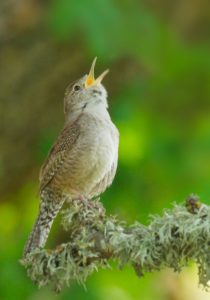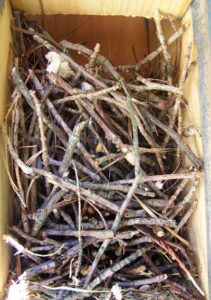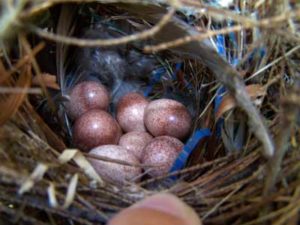Nest boxes for House Wrens. An unhelpful plan.

House Wren by Tom Grey
We are happy to say that this native cavity-nesting bird, the House Wren, does not need the added assistance of nest boxes. And we further want to offer reasons why we should avoid increasing their housing opportunities by artificial means.
This charming songster is the most abundant cavity-nester in North America! It’s population is 160,000,000 and the North American Bird Conservation Initiative’s Species Assessment Summary has given it a very low conservation concern score.
What does this mean? Well, among other favorable conditions the bird enjoys, it means that House Wrens have tremendous nesting success, in great part because they have adapted to raising a family in a myriad of locations apart from holes in dead trees. (Even a human boot left outdoors is acceptable to this wren!) Their enormous numbers and wide range is sufficient justification to avoid artificially boosting their numbers. However, there are other equally important reasons to avoid placing boxes in wren habitat, which by the way, may include some backyards. This is often where hopeful and well-intended homeowners place nest boxes to attract bluebirds, but instead inherit a House Wren family. Here is an important point however! Once eggs are laid, bird protection regulations require that all native birds are left undisturbed. That’s code for, do not move or destroy their nest if it contains eggs or young still dependent on their parents.

Characteristic twigs left by wrens Sails.org
But here is the full truth about this otherwise delightful bird. During the nesting season, both male and female House Wrens are documented as being highly aggressive toward both cavity-nesters and open-cup nesters. Their passive and aggressive actions include filling cavities with twigs to make them unusable by other birds, and destroying their nests and eggs indiscriminately.
When other birds share nesting territory with House Wrens, their nesting success is therefore further challenged. There is evidence suggesting that the species has already negatively impacted the Bewick’s Wren in the East. Not only does their aggressive competition threaten species diversity in some situations, but the scientific literature suggests that fear of predation (which they may set in motion) is one of the strongest driving forces behind where and when birds choose to nest.

Eggs of House Wren Sails.org
Concerns about increased competition and species diversity is a wider one relevant to the use of nest boxes overall, especially in the case of the highly popular Western, Mountain and Eastern Bluebird for whom many thousands of nest boxes have been placed across the country and admittedly greatly boosted and stabilized their populations. The concern about the impact of large numbers of nest boxes now emerges in scientific literature as well as in a statement from the Cornell Lab of Ornithology: “Care must be taken that advances of bluebird populations are not made at the expense of other native bird populations and not accompanied by loss of species diversity in managed areas.”
Nest boxes have helped stabilize the populations of several species, increased enjoyment of birds on the part of ordinary citizens, and been a boost to scientific study in the field. These wonderful benefits need to be balanced with an understanding that unless a species is endangered, the best conservation plan is not one that relies permanently on artificial means for personal pleasure and to benefit a favored species. If a species needs help, the best plan is one that supports those specific natural conditions required by it. In this way, the conservation plan benefits all the birds/wildlife that also rely on those conditions. Such a plan also includes consideration of the larger ecological system.
To learn more about the House Wren please open this link: https://www.allaboutbirds.org/guide/House_Wren/lifehistory


Connect
Connect with us on the following social media platforms.